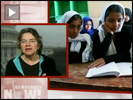Inauguration 2017 Special Coverage w/ Angela Davis, Naomi Klein, Ralph Nader & More
Menu

Special coverage in the Trump Era
From Public Citizen's Corporate Presidency site: "44 Trump administration officials have close ties to the Koch brothers and their network of political groups, particularly Vice President Mike Pence, White House Legislative Affairs Director Marc Short, EPA Administrator Scott Pruitt and White House budget director Mick Mulvaney."
Dark Money author Jane Mayer on The Dangers of President Pence, New Yorker, Oct. 23 issue on-line
Can Time Inc. Survive the Kochs? November 28, 2017 By Jane Mayer
..."This year, among the Kochs’ aims is to spend a projected four hundred million dollars in contributions from themselves and a small group of allied conservative donors they have assembled, to insure Republican victories in the 2018 midterm elections. Ordinarily, political reporters for Time magazine would chronicle this blatant attempt by the Kochs and their allies to buy political influence in the coming election cycle. Will they feel as free to do so now?"...
"Democracy in Chains: The Deep History of the Radical Right’s Stealth Plan for America" see: our site, and George Monbiot's essay on this key book by historian Nancy MacLean.
Full interview with The New Yorker’s Jane Mayer March 29, 2017, Democracy Now! about her article, "The Reclusive Hedge-Fund Tycoon Behind the Trump Presidency: How Robert Mercer Exploited America’s Populist Insurgency."
Democracy Now! Special Broadcast from the Women's March on Washington
The Economics of Happiness -- shorter version
Local Futures offers a free 19-minute abridged version of its award-winning documentary film The Economics of Happiness. It "brings us voices of hope of in a time of crisis." www.localfutures.org.
What's New?
February 26, 2010
Phyllis Bennis on Ending the US War in Afghanistan
Phyllis Bennis is a fellow of the Institute for Policy Studies and author, most recently, of Ending the US War in Afghanistan: A Primer. The interview was on "Democracy Now" on February 23, 2010.
"In Afghanistan, the number of civilian casualties continues to rise. On Tuesday, at least eight people died after a bomb exploded in the southern provincial capital of Lashkar Gah amid a major US-led offensive in the area. Local authorities said all those killed in the attack were civilians. Meanwhile, Afghanistan’s government has condemned a NATO air strike on a convoy on Sunday that killed twenty-seven civilians, including four women and a child. NATO commander General Stanley McChrystal went on Afghan television to apologize for the attack. Last year was the deadliest of the war for civilians and foreign troops. And while there is no reliable count of the number of Afghans killed, the number of US soldiers killed in the war has reached 1,000....
..."The exit strategy has to start by ending the killing. There has to be a unilateral ceasefire that can set the stage hopefully for a reciprocal ceasefire from all the various parties that are at war here. It has to include—this isn’t a situation where we can simply say, “Oh, let’s pull out the troops, and then we’re done.” Pulling out the troops, ending the drone attacks, ending these attacks that so consistently are killing civilians, is only step one. It’s only step one. We need to reengage with Afghanistan in an entirely different way than has been made possible. We need to look at serious development assistance."...
Read the transcript of this interview, find links for the radio and TV interview.


